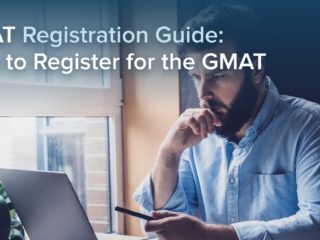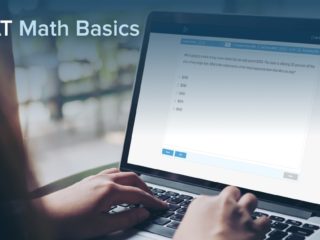| Getting your Trinity Audio player ready... |
Last Updated on June 19, 2024
In investigating test-taking strategies for exams such as the GMAT, many students look for ways to stay grounded, focused, and calm during their test preparation and their exam. After all, the process of preparing for and taking such a consequential exam is, undoubtedly, stressful and draining at points. So, having the right test-taker mindset for success is essential to staying the course and, ultimately, performing at our best on test day.
Mindfulness is one tool we can use to achieve the calm, focused mindset we need to excel on the GMAT. In this article, we’ll discuss GMAT mindfulness exercises for test preparation and for test day, including breathing exercises, meditation techniques, and yoga. We’ll also discuss mindfulness-based stress reduction for exams and whether maximizing test scores with mindfulness is really possible.
Whether you’re interested in incorporating mindfulness meditation into GMAT prep or looking for quick ways to “reset” during stressful moments of your exam, read on!
Here are the topics we’ll cover:
- Mindfulness and Meditation for Test-Taking: The Science Behind the Hype
- Mindfulness Meditation
- Mantra Meditation
- Mindful Yoga Exercises for Exam Stress
- Mindfulness During Exam Day
- Mindfulness Resources for Test-Taking
- Key Takeaways
- What’s Next?
First off, let’s take a look at some of the science behind mindfulness practices.
Mindfulness and Meditation for Test-Taking: The Science Behind the Hype
There is a substantial body of scientific evidence that mindfulness-based practices, notably meditation, can help students perform better on exams. These practices work to lower stress and improve one’s ability to cope with stress. They also appear to improve memory, focus, and knowledge retention.
For example, a 2013 randomized, controlled study published in the journal Psychological Science found that just two weeks of mindfulness training improved GRE Reading Comprehension scores and working memory and reduced distracting thoughts among test-takers as they were completing the GRE.
Similarly, a 2015 study found that university students who took a semester-long mindfulness meditation course performed better on computer-administered cognitive tasks than students who didn’t take the course, with improved reaction times and working memory.
Likewise, a 2017 study found that university students who engaged in just five minutes of focused-attention meditation at the beginning of a class performed significantly better on a quiz at the end of the class than students who didn’t engage in the meditation exercise. Furthermore, when both groups engaged in the five-minute meditation, the gap between their quiz scores closed.
These are just a few examples of the scientifically backed benefits of mindfulness training for academic achievement. And it’s not that surprising that mindfulness can benefit test-takers, right? After all, most of us know that when we’re very stressed or anxious, our minds tend to get jumbled. Maintaining focus and retaining information become far more challenging.
Thus, when we train ourselves to remain calm and focused, as mindfulness does, we’re better able to take in and recall information and direct our attention as we’d like, even during stressful moments.
So, let’s look at two common ways to cultivate mindfulness: meditation and yoga.
KEY FACT:
Mindfulness exercises have been shown to improve test performance.
Mindfulness Meditation
Mindfulness meditation is sometimes called breath awareness meditation or focus meditation. (In the case of the 2017 study referenced above, this practice was called focused-attention meditation. Note that in the case of focus meditation, you could focus on either your breath or on a physical object. However, the participants in the 2017 study did in fact focus on their breath.)
Whatever it’s called, the basic steps to engage in mindfulness meditation remain the same:
- Sit in a comfortable position.
- Breathe naturally, noticing your breath.
- Continue to breathe naturally, and focus your attention on your breath. Feel the sensation of breath entering and leaving your mouth or nostrils, and the sensation of your chest rising and falling.
- If your mind wanders to something other than your breathing, readjust your focus to the breath you’re taking.
That’s it! Not so intimidating, right? You can use mindful breathing exercises for test anxiety, reducing stress, and improving your attention span.
Now, you may say, I have too many thoughts racing through my mind to be able to sit in one spot and think about nothing but my breath. This worry discourages many people from attempting mindfulness meditation. So, let’s explore why this common concern actually isn’t something we should worry about.
The Fallacy of “Emptying” Your Mind
Here’s the thing that people often don’t realize about mindfulness meditation. You do not have to “empty your mind” to engage in it — and reap its benefits.
How likely does it seem that the students who performed five minutes of impromptu meditation at the beginning of a class magically had no thoughts in their heads the moment they started meditating? It seems pretty much impossible, right? So, we needn’t have such an unrealistic expectation for ourselves.
Remember step 4: if your mind wanders, reset your focus back to your breath. The expectation is that there will be times when your mind wanders. Part of mindfulness training is the process of noticing your mind wandering and refocusing your attention. By practicing this refocusing again and again, we teach ourselves an important skill that we can then deploy during other activities — for example, while taking a stressful exam! So, we can actually think of getting distracted during meditation as a positive.
If a particular thought or worry distracts you from focusing on your breath, cognitive reappraisal can also be helpful. Cognitive reappraisal simply means reframing an occurrence or thought that you might consider negative.
For example, if you get distracted while meditating, you might think, “I’m doing this wrong,” “I can’t do this,” or “I’ll never get this right.” In that case, you can tell yourself, “I’m allowed to get distracted” or “it’s just a thought.” Then, reset your attention on your breath.
And here’s another important point to remember. The more you engage in mindfulness meditation, the better you’ll become at focusing on your breath.
TTP PRO TIP:
Think of getting distracted during meditation, and then refocusing your attention, as an important part of your mindfulness training.
Mantra Meditation
Breath meditation isn’t for everyone, but there are alternatives. Particularly if you find that intrusive thoughts are a significant problem during breath meditation, or you simply don’t enjoy breath-focused meditation or would like to try something else, mantra meditation can provide similar benefits.
During mantra meditation, instead of focusing on your breath, you repeat a word or phrase over and over again. If you’re picturing someone sitting with eyes closed, chanting the word “Om,” yes, technically, that is mantra meditation. However, you can choose any “mantra” you like, from a few meaningless syllables that roll off the tongue to a word you like the sound of to a short, positive affirmation.
You can also try out different mantras to see what works best for you, or use different mantras during different meditation sessions. For example, maybe you have a certain mantra for times when you need to quell anxiety and another mantra for days when you want to improve your mood.
Some people find mantra meditation less frustrating than breath meditation because, in a sense, repeating a mantra is a built-in distraction. In other words, you’re “doing” something, so boredom or wandering thoughts may not be as much of an issue.
Keep in mind that you can repeat your mantra silently in your head or out loud. And, as with breath meditation, mantra meditation sessions don’t have to be long in order for you to reap benefits. In fact, for many people, it’s a good idea to start small, incorporating even just a few minutes of meditation into your day, and work your way up to longer sessions over time.
TTP PRO TIP:
Whether you’re seeking meditation techniques for test anxiety or to increase focus and memory, both breath-focused and mantra meditation are effective tools.
Mindful Yoga Exercises for Exam Stress
Yoga prompts us to pay attention to our bodies and our breathing. So, given our discussion so far, it’s no surprise that yoga promotes mindfulness. Additionally, numerous studies suggest that yoga helps promote relaxation, reduce stress and anxiety, and improve mood. According to a 2020 meta-analysis in Frontiers in Integrative Neuroscience, yoga may even help with attention and executive function.
If you’re looking to relieve GMAT stress, it’s probably best to try poses that aren’t overly strenuous or difficult — particularly if you’re a beginner. Search “yoga for stress relief,” “gentle yoga,” or “restorative yoga” on YouTube and you’ll find plenty of free videos you can follow at home. These videos generally range from 10 to 40 minutes, so you can easily incorporate them into your day.
For example, say you’ve been at your desk studying for the GMAT for a couple of hours during a long, weekend study session. Fifteen minutes of yoga is a great way to take a break and get some blood flowing to your brain, so you can put in more study time feeling calm and re-energized.
Additionally, if GMAT stress has been keeping you up at night, incorporating yoga into your nighttime “wind down” routine could help you fall asleep more easily and get more restful sleep. Check out these 7 poses that Harvard Medical School recommends.
You can also take a yoga class at your local gym or yoga studio. Yoga classes can be a great way to blow off steam and have some fun. Plus, they can make the GMAT prep process feel less isolating. And since they meet at set times, they can help you establish a routine that includes dedicated mindfulness time.
TTP PRO TIP:
Break up a long GMAT study session with 10 or 15 minutes of yoga.
Mindfulness During Exam Day
So far, we’ve discussed mindfulness-based self-care tips for test preparation. But what about effective test-day strategies to reduce stress and stay focused? Clearly, you’re not going to stand up and do tree pose during your GMAT, or take five to meditate after a tough Quant question.
That said, there are deep breathing techniques for stress relief that you can employ during your actual GMAT. Additionally, you can employ focus techniques for test-taking that are related to the mindfulness exercises we’ve already discussed.
For one, if you’ve been practicing mindfulness meditation during your GMAT prep, you can use the refocusing “muscles” you’ve developed, as well as cognitive reappraisal, to bring your attention back to the GMAT question in front of you if you start to lose focus.
You can focus intently on the question in front of you just as you would your breath during meditation. Try applying this skill when you’re answering practice questions or taking full-length practice tests as well.
If anxiety starts to overwhelm you during your GMAT, you can put yourself in a calmer state by taking some slow, deep breaths. The breaths shouldn’t stop in your chest but go lower, into your abdomen. This type of breathing is one of the quickest and most effective ways to reduce anxiety.
Again, you don’t have to wait until test day to practice deep breathing. Try it when reviewing concepts, tackling tough practice questions, or gearing up for a study session on a stressful day.
TTP PRO TIP:
Try deep breathing and cognitive reappraisal if you get anxious, stressed, or distracted during your GMAT.
Mindfulness Resources for Test-Taking
In addition to the resources we’ve already discussed, there are a variety of mindfulness apps available for download. Some are free and some are subscription-based. (Here is a review of a few of the more well-known ones.)
That said, you’re unlikely to find mindfulness apps for test preparation specifically. However, you will find apps offering guided meditations that use the same techniques we’ve discussed. Other mindfulness apps feature soothing images and music, which you may find helpful for reducing stress or tackling insomnia.
You also may want to check out these free guided meditations from UCLA, which are available in numerous languages. UCLA also offers a free meditation app called UCLA Mindful, which is available on iTunes and Google Play. The app features instructions on meditating, mindfulness podcasts, and guided meditations for various purposes.
Key Takeaways
GMAT test-takers and mindfulness exercises may not be two things you’d normally associate. However, scientific evidence supports the effectiveness of practicing mindfulness for exam stress relief and improved performance on exams.
Of course, GMAT mindfulness exercises are not a silver bullet. Although studies show improved test performance among students practicing mindfulness, achieving higher percentile points with mindfulness techniques is by no means a given.
Rather, consider mindfulness meditation and relaxation techniques for standardized tests one tool among many to help you make the most of your study time and perform at your best on test day.
Nurturing mental wellness for test preparation ultimately will serve you well on your GMAT. So, if you’re having trouble staying focused, feeling burned out, or simply looking to pull every lever possible to gain an edge on your exam, try some of the exercises we’ve discussed in this article. You may be surprised at the benefits!
What’s Next?
If you’re lacking confidence in your GMAT abilities, these 10 confidence-building techniques can help.
Having trouble staying motivated on the long road to test day? Check out this expert advice on finding your GMAT motivation.
Also, learn how to turn your GMAT anxiety into excitement to improve your GMAT score.



